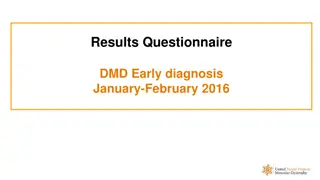Understanding Hemangiopericytoma: Symptoms, Diagnosis, and Treatment
Hemangiopericytoma is a rare soft tissue tumor originating from pericytes in capillaries. Learn about its symptoms, diagnosis methods, treatment options, and the role of pathology and IHC. Follow-up care, adrenal tumor functionality, and potential associations with MEN syndrome are also discussed.
Download Presentation

Please find below an Image/Link to download the presentation.
The content on the website is provided AS IS for your information and personal use only. It may not be sold, licensed, or shared on other websites without obtaining consent from the author. Download presentation by click this link. If you encounter any issues during the download, it is possible that the publisher has removed the file from their server.
E N D
Presentation Transcript
IN THE NAME OF GOD
questions What is hemangiopericytoma? What are the symptoms of hemangiopericytoma? How can we diagnosis this tumor before surgery? What are the treatment of this tumor? How can pathology & IHC help in diagnosis? What should we do in follow-up? Is the contralateral adrenal tumor in our patient functional? How MACS should be evaluated and be treated? Can MEN syndrome be considered the diagnosis of our patient?
questions What is hemangiopericytoma? What are the symptoms of hemangiopericytoma? how can we diagnosis this tumor before surgery? What are the treatment of this tumor? How can pathology & IHC help in diagnosis? What should we done in follow up? Is the contralateral adrenal tumor in our patient functional ? How MACS should be evaluated and be treated? Can MEN syndrome be considered the diagnosis of our patient?
hemangiopericytoma Hemangiopericytomas are rare tumors originating from pericytes in the wall of capillaries. It is a type of soft tissue sarcoma which commonly involves the lower extremities, pelvic retro peritoneum, and head & neck. case of meningeal hemangiopericytoma metastatic to the adrenal gland.
questions What is hemangiopericytoma? What are the symptoms of hemangiopericytoma? how can we diagnosis this tumor before surgery? What are the treatment of this tumor? How can pathology & IHC help in diagnosis? What should we done in follow up? Is the contralateral adrenal tumor in our patient functional ? How MACS should be evaluated and be treated? Can MEN syndrome be considered the diagnosis of our patient?
primary hemangiopericytoma of the adrenal gland Symptoms of HPC are non specific. In 66% of cases, the presentation is a painless abdominal tumor Other symptoms are: hematuria (if with infiltration to the kidney) hypoglycemia (extended glucose metabolism , para neoplastic(IGF2) arterial hypertension( renin production)
questions What is hemangiopericytoma? What are the symptoms of hemangiopericytoma? how can we diagnosis this tumor before surgery? What are the treatment of this tumor? How can pathology & IHC help in diagnosis? What should we done in follow up? Is the contralateral adrenal tumor in our patient functional ? How MACS should be evaluated and be treated? Can MEN syndrome be considered the diagnosis of our patient?
hemangiopericytoma Despite technical advances in the field of imaging, no characteristic signs of HPC have been described on ultrasonography, CT or MRI that might aid in the differential diagnosis. These studies usually depict a large mass, which may grow insidiously to a diameter of 25 cm, but with no pathognomonic features.
questions What is hemangiopericytoma? What are the symptoms of hemangiopericytoma? how can we diagnosis this tumor before surgery? What are the treatment of this tumor? How can pathology & IHC help in diagnosis? What should we done in follow up? Is the contralateral adrenal tumor in our patient functional ? How MACS should be evaluated and be treated? Can MEN syndrome be considered the diagnosis of our patient?
treatment Surgical removal is still the mainstay of the treatment of HPC, and should be as radical as possible in order to avoid incomplete resection and recurrence.
macroscopy most tumors are well circumscribed lesions or a thin capsule, complex network of vessels and, with small satellite nodules around the main mass. Only the minority is adhered to neighboring tissues. Tumor size reported in the literature range between 2 and 25cm.
questions What is hemangiopericytoma? What are the symptoms of hemangiopericytoma? how can we diagnosis this tumor before surgery? What are the treatment of this tumor? How can pathology & IHC help in diagnosis? What should we done in follow up? Is the contralateral adrenal tumor in our patient functional ? How MACS should be evaluated and be treated? Can MEN syndrome be considered the diagnosis of our patient?
questions What is hemangiopericytoma? What are the symptoms of hemangiopericytoma? how can we diagnosis this tumor before surgery? What are the treatment of this tumor? How can pathology & IHC help in diagnosis? What should we done in follow up? Is the contralateral adrenal tumor in our patient functional ? How MACS should be evaluated and be treated? Can MEN syndrome be considered the diagnosis of our patient?
Follow up Recurrence can be as high as 37.5%. repeat CT-scan must be done every 6 months after surgery for 2 years then annually thereafter to document any recurrence. For large tumors, preoperative embolization can be done and has been reported in 2 cases. There is no role of radiotherapy and chemotherapy in the treatment of HPC.
questions What is hemangiopericytoma? What are the symptoms of hemangiopericytoma? how can we diagnosis this tumor before surgery? What are the treatment of this tumor? How can pathology & IHC help in diagnosis? What should we done in follow up? Is the contralateral adrenal tumor in our patient functional ? How MACS should be evaluated and be treated? Can MEN syndrome be considered the diagnosis of our patient?
99/8/25 99/9/5 99/9/10 99/9/20 DHEAS 25.6 microgram/dl (56.2_283) 33 microgram/dl Cortisol 8 AM 8.88 Microgram/dl (6.2_20) 19.74 microgram/dl Cortisol PM 2.39 Microgram/dl (2.3_11.9) ACTH 8.05 picogram /ml (7.2_64) 6.97 pg/ml IGF_1 113 ng/ml(94_252) GH 0.11 ng/ml(0.1_10) PRA 0.41 ng/ml/h(0.5_4) Aldosterone 19.6 ng/dl(3.7_43) Urine culture negative Urine analysis normal HbA1C 6% Vitamin B12 282 pg/ml (187_883) Overnight Dexamethasone 2.75 2.4
Modern Management of Mild Autonomous Cortisol Secretion Clin Pharmacol Ther. 2019 Dec;106(6):1209-1221
questions What is hemangiopericytoma? What are the symptoms of hemangiopericytoma? how can we diagnosis this tumor before surgery? What are the treatment of this tumor? How can pathology & IHC help in diagnosis? What should we done in follow up? Is the contralateral adrenal tumor in our patient functional ? How MACS should be evaluated and be treated? Can MEN syndrome be considered the diagnosis of our patient?
Additional tests for patients with abnormal DST include: basal ACTH ,suppressed < 10 pg/ml ,ACTH independent cortisol hypersecretion SH patients do not benefit much from UFC measurement , mainly because of the low sensitivity in detecting mild cortisol excess. DHEAS levels less than 40 mg/dL had a specificity of 75% and a sensitivity of 68% in identifying SH. DHEAS offered comparable sensitivity and greater specificity to the 1- mg DST for the detection of SH. Recent Advances on Subclinical Hypercortisolism Endocrinol Metab Clin North Am. 2018 Jun;47(2):375-383.
Assessment and management of autonomous cortisol secretion in patients with adrenal incidentalomas
questions What is hemangiopericytoma? What are the symptoms of hemangiopericytoma? how can we diagnosis this tumor before surgery? What are the treatment of this tumor? How can pathology & IHC help in diagnosis? What should we done in follow up? Is the contralateral adrenal tumor in our patient functional ? How MACS should be evaluated and be treated? Can MEN syndrome be considered the diagnosis of our patient?
Methods: Analysis of records from 715 MEN1 patients from a multicentre database between 1956 and 2008. Adrenal lesions were compared with those from a multicentre cohort of 144 patients with adrenal sporadic incidentalomas. European Journal of Endocrinology (2012)166 269 279























